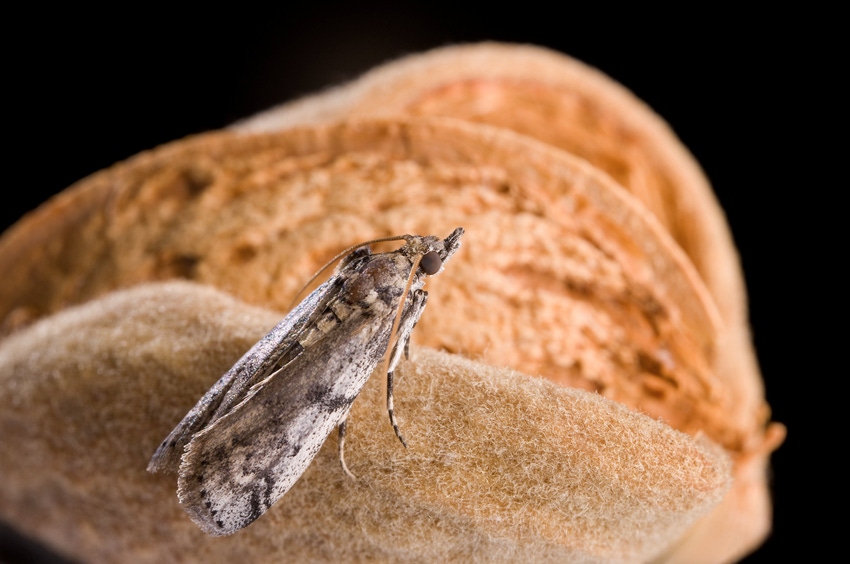
Sterile insect technology could help thwart Navel orangeworm pest in pistachios, almonds
Proven sterile insect technology used to help eradicate the pink bollworm in Far West and Southwest cotton fields could help western tree nut growers battle the Navel orangeworm.NOW is the number one pest threat in California pistachio orchards, and a significant pest in almonds.
July 8, 2015

Sterile insect technology (SIT) is a critical component towards the eradication of the pink bollworm (PBW) insect (Pectinophora gossypiella) in Far West and Southwest cotton fields.
This method in turn could help pistachio and almond growers combat the destructive Navel orangeworm pest, Amyelois transitella.
The cotton industry is working with various groups to possibly use a section of the Pink Bollworm Rearing Facility building in Phoenix to rear and sterilize Navel orangeworm (NOW) insects for release in California pistachio and almond orchards.
The rearing facility is owned by California cotton growers with oversight by the California Department of Food and Agriculture.
“Navel orangeworm is an extremely devastating pest in pistachios and almonds,” said Clyde Sharp of Roll, Ariz., a state and national cotton leader and advocate of SIT in PBW eradication.
Sharp says some California tree nut growers spend up to $250 per acre annually controlling the Navel orangeworm.
He discussed this issue during the 2015 Arizona Cotton Conference held in Flagstaff, Ariz. in June.
PBW eradication success
Here is how SIT has worked with PBW in cotton.
After reared PBW moths are sterilized at the Phoenix rearing facility, the moths are loaded onto Cessna aircraft and released over cotton fields. The steriles, and any natives in the field, attempt to mate, yet unsuccessfully.
This is followed by the natural death of the native moth without producing offspring. The reproduction cycle ends.
The pink bollworm damages squares and bolls with the latter damage the most serious. According to the University of California IPM website, a larva burrows through the boll as it cuts and stains the lint. The result is severe lint quality loss.
Aerial dispersal of sterile PBW has been conducted for years over cotton fields in California, Arizona, New Mexico, and West Texas.
Yet sterile moths are not the only bullet in the chamber towards eradication. Other critical components are Bt cotton, pheromone mating disruption, insecticides, plow down, trapping, and other practices.
Combined, these practices create an integrated pest management approach which has rapidly reduced native PBW numbers in the Far West and Southwest over the last decade.
SIT success in cotton
The last native “pinkie” insect found in Arizona was in Yuma County in 2012; 2011 in all other cotton areas of the state.
The success of the pinkie eradication program is remarkable. For example, native captures in central and eastern Arizona in 2006 totaled 657,000. The number plummeted to zero six years later (2012) and has remained at zero.
“We have accomplished eradication in Arizona, California, and northern Mexico but we do not have confirmed eradication,” Sharp told the cotton crowd.
Sharp serves as the National Cotton Council’s (NCC) secretary-treasurer and previously served as chairman of the Arizona Cotton Growers Association and the Arizona Cotton Research and Protection Council.
In 2014, he received the coveted Western Farm Press High Cotton Award.
Win-win for cotton, tree nuts
If the SIT-NOW program is implemented, it could be a win-win for NOW control and the future of the cotton industry.
While official pinkie eradication could be close, the need still exists to keep the Phoenix rearing facility open in case a local outbreak of pinkies is found and sterile moths are quickly needed.
If a new native population were found, sterile pinkies could be produced at the facility and released by plane over the find area in about 30 days.
Testing is underway this year on unmanned aerial vehicles (drones) to possibly drop steriles on fields in a small outbreak. This method could allow the sterile moth drop just days after a find.
Sharp says keeping the rearing facility open would cost about $2.5 million a year for a problem that may or may not occur in the future.
“If the federal government decides to stop funding this program, where would the money come from within a cotton industry which continues to face reduced acreage?,” Sharp asked.
Dedicating part of the facility for sterile NOW moth production could help pay the bills. Sharp calls this option a win-win for tree nut and cotton growers.
You May Also Like



